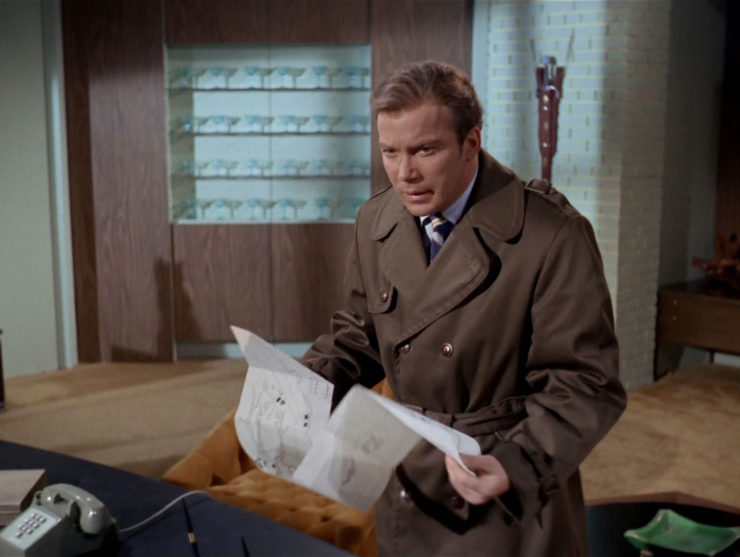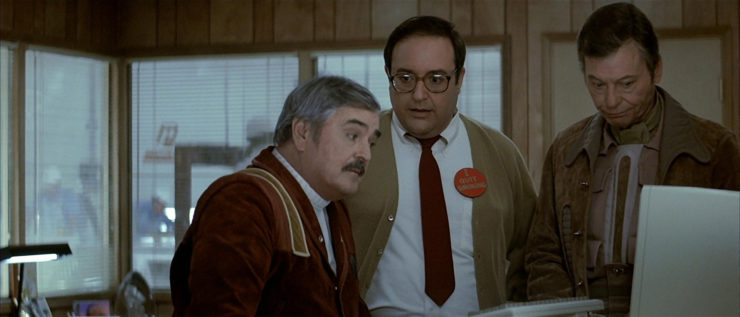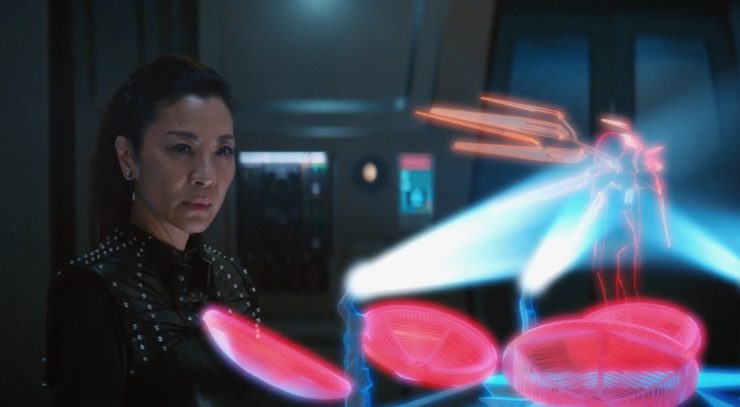At the very start of the Star Trek: Discovery episode “The Red Angel,” the history of time travel in the Trek universe got a little more wrinkled. According to this episode, Starfleet has been desperate to develop some reliable time travel since the very early part of the 23rd century. This feels a little crazy, but what’s even crazier is that a close reading of nearly every single time travel episode of the original series supports this idea. Yep. That’s right. Discovery’s “temporal arms race” seems to be something Captain Kirk was totally involved with during TOS. Here’s how it all works.
Spoilers ahead for Star Trek: Discovery, Season 2, Episode 10, “The Red Angel.”
In “The Red Angel,” Captain Leland says that Starfleet started trying to develop time travel technology because they were worried the Klingons would do it first, and go back in time and prevent humanity from ever existing. In the context of this episode, Leland’s revelation helps to explain the Red Angel/Project Daedalus suit and the fate of Burnham’s parents. But this “temporal arms race” has wider implications beyond this season of Discovery.
The notion that Section 31 agents have already time traveled at this point in Trek history is confirmed by this episode. We know one Section 31 agent—Michael Burnham’s mom—has traveled through time, but what if she’s not the only one? At no point does Leland say that Project Daedalus was the only time travel tech being developed by Section 31. The Red Angel suit seems to rely on those notoriously unpredictable time crystals Harry Mudd had in the season 1 episode, “Magic to Make the Sanest Man Go Mad,” which means the temporal arms race must have caused Section 31 to pursue other ways of making time travel work consistently.
Fast-forward from 2257 (Discovery) to 2265 (the original Star Trek). At the end of the episode “The Naked Time,” Kirk, Spock and the crew of the Enterprise accidentally stumble upon a super-reliable form of time travel: the so-called slingshot-effect. This is the same technique that Kirk will use on-purpose in “Assignment: Earth” and, more famously, in Star Trek IV: The Voyage Home. In Trek’s second ever time travel episode, “Tomorrow Is Yesterday,” the Enterprise is thrown back to Earth’s past via the slingshot-effect caused by a “black star” hanging out near Starbase 9. Early in the episode, Kirk tells Uhura that he wants Starfleet to know about the location of the black star, ASAP.
Now, the obvious reason Kirk does this is that the black star is a navigational hazard. But the less-obvious reason may be that Kirk has standing orders to document and report anything he discovers about time travel. Is Kirk working for Section 31? Probably not, but he might actively be gathering intel for Starfleet about time travel. This may sound far-fetched, but in “The City on the Edge of Forever,” the Enterprise is straight-up investigating crazy time distortions, and Kirk is really quick to make sure Starfleet knows what he’s doing. Famously, the episode is just a cold-open on the Enterprise passing through dangerous waves in time, in orbit of the planet which is home to the Guardian of Forever. Kirk quickly tells Uhura to send Starfleet all of his logs about “the strange readings on our instruments…and how they led us here.” Kirk calls this move a “precautionary measure,”—Kirk knows how dangerous and unpredictable time travel can be, but it also suggests that as Starfleet captain, he knows that time travel phenomenon has huge strategic importance. The takeaway here is obvious: Kirk brings the Enterprise to a dangerous planet, on purpose, to investigate the slightest possibility of time travel tech. If we take the Discovery continuity seriously, this could mean Kirk wasn’t just curious about temporal distortions. Instead, it was part of his job.

The final piece of the TOS time travel puzzle is “Assignment: Earth,” an episode in which Kirk and Spock basically behave more like Section 31 agents than they do Starfleet officers. In this episode, the Enterprise is actually ordered to travel back in time to Earth’s past to observe the launch of an orbiting nuclear platform in 1968. Obviously, the existence of this orbiting nuclear platform is mostly fictitious, but the fact that the Enterprise is traveling through time—using the slingshot effect—as a matter of course at this point is deeply revealing. In some ways, the Enterprise’s flagrant time travel could be the Starfleet version of temporal saber rattling. There’s nothing to suggest that the mission of the Enterprise is being kept secret at all, which suggests Starfleet may have wanted other governments to know about it. In other words: Hey, guess what Klingons! We’re so good at time travel, we can go back in time to our own planet and mess with nuclear proliferation! So, you know, don’t mess with us!
“Assignment: Earth” also is vaguely suggestive of Discovery insofar as Gary Seven is aware of time travel and the future history of the galaxy. In “The Red Angel,” Leland floats the theory that certain technological leaps on Earth were a result of time travel. Aspects of “Assignment: Earth” suggest this in reverse: because of time travel interference from the Enterprise, the United States decides not to pursue orbital nuclear technology. Plus, the fact that Gary Seven has such advanced tech (some of which might be from the future) certainly indicates some of that tech could have leaked into 20th century Earth.
(The only other time travel episode in TOS is “All Our Yesterdays,” in which the Enterprise stumbles on some time alien tech, but that really seems like an accident. Kirk wouldn’t get himself accused of being a witch, on purpose, right?)
Anyway, Leland’s theory about time travel creating advanced technology is already proven true in the existing Trek movies. Famously, in Star Trek IV: The Voyage Home, Scotty, and Bones create (or fulfill?) a bootstraps paradox by giving the recently-tobacco free Dr. Nicholas the formula for transparent aluminum. When Bones worries that he and Scotty are altering the past, Scotty quips, “How do we know he didn’t invent the thing?” It’s one of the greatest jokes in The Voyage Home, but in the context of time travel in Trek canon, it totally seems to indicate that on some level, Scotty buys into the exact same theory that Leland mentions in “The Red Angel.”

Scotty is not a Section 31 agent. Kirk probably isn’t either. But, by the time of the original series, and well into the classic movies, Starfleet is obsessed enough with time travel that everyone is thinking about it all the time. And, if Discovery does prove that certain advanced technology in Star Trek is created by time travel paradoxes, then suddenly, a lot of the tech inconsistencies across all the various incarnations of the franchise can easily be explained. And yes, this all could mean that Tyler’s TNG-style combadge was totally created by a bootstraps paradox. Or, to put it in Scotty-parlance; how do we know Tyler didn’t invent the thing?
Ryan Britt is the author of Luke Skywalker Can’t Read and an editor at Fatherly. He is a longtime contributor to Tor.com.










